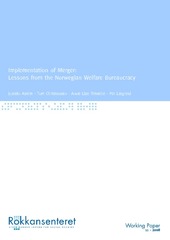| dc.contributor.author | Askim, Jostein | eng |
| dc.contributor.author | Christensen, Tom | eng |
| dc.contributor.author | Fimreite, Anne Lise | eng |
| dc.contributor.author | Lægreid, Per | eng |
| dc.date.accessioned | 2010-10-28T10:30:21Z | |
| dc.date.accessioned | 2020-12-10T06:33:05Z | |
| dc.date.available | 2010-10-28T10:30:21Z | |
| dc.date.available | 2020-12-10T06:33:05Z | |
| dc.date.issued | 2008-08 | eng |
| dc.identifier.issn | 1503-0946 | |
| dc.identifier.uri | https://hdl.handle.net/1956/4291 | |
| dc.description | This paper is part of the ongoing evaluation of the reform in the Norwegian employment and welfare administration funded by the Norwegian Research Council. The paper is part of the sub-project in this evaluation named Welfare model, governance system and NAV (the Norwegian acronym for the employment and welfareadministration), headed by professor Tom Christensen. The paper has been presented at the ECPR Standing Group on regulatory Governance Biennial Conference on (Re)Regulation in the Wake of Neoliberalism. Consequences of Three Decades of Privatization and Market Liberalization, Utrecht, 5–6 June 2008. | en |
| dc.description.abstract | This paper aims to contribute to scholarly knowledge about public-sector mergers by analyzing a recent merger in the Norwegian welfare bureaucracy. The merger studied is one of the largest oriented reforms in recent Norwegian public administration history. The government decided in 2005 to merge the employment and national insurance services into a new entity called the Norwegian Labour and Welfare Service (NAV). We examine how instrumental problem-solving in the merger was conditioned by external forces, internal negotiations and cultural features by focusing on the first step in the implementation of the merger – the transition process that took place in 2005–2006. We examine the framing of the transition process, the activation of participants and agendas, and organizing the NAV at the central level. A main finding is that the scope for instrumental problem-solving is most of all conditioned by internal conflicts, to some extent by external control and to a lesser extent by cultural features | en_US |
| dc.description.abstract | Siktemålet med dette paperet er å bidra til å øke kunnskapsgrunnlaget om sammenslåinger av offentlige organisasjoner ved å analysere NAV-reformen som er en av de største forvaltningsreformene i Norge. Regjeringen bestemte i 2005 å slå sammen A-etat og Rikstrygdeverket til en ny arbeids- og velferdsetat. Vi undersøker instrumentell problemløsning var betinget av ytre krefter, interne forhandlinger og kulturelle bindinger ved å fokusere på den første del av iverksettingsfasen fra 2005–2006. Vi studerer hvordan omstillingsprosessen ble rammet inn, aktivisering av deltakere og saksområder og på hvordan NAV ble organisert på sentralt plan. Et hovedfunn er at rommet for instrumentell problemløsning ble først og fremst begrenset av interne konflikter, men også til en viss grad av ytre kontroll. Kulturelle faktorer hadde også betydning men var mindre fremtredende. | en_US |
| dc.language.iso | eng | eng |
| dc.publisher | Stein Rokkan Centre for Social Studies | eng |
| dc.relation.ispartofseries | Working Paper | en |
| dc.relation.ispartofseries | 11-2008 | en |
| dc.title | Implementation of Merger: Lessons from the Norwegian Welfare Bureaucracy | eng |
| dc.type | Working paper | eng |
| dc.rights.holder | Copyright Stein Rokkan Centre for Social Studies. All rights reserved | |
| dc.subject.nsi | VDP::Samfunnsvitenskap: 200 | nob |
